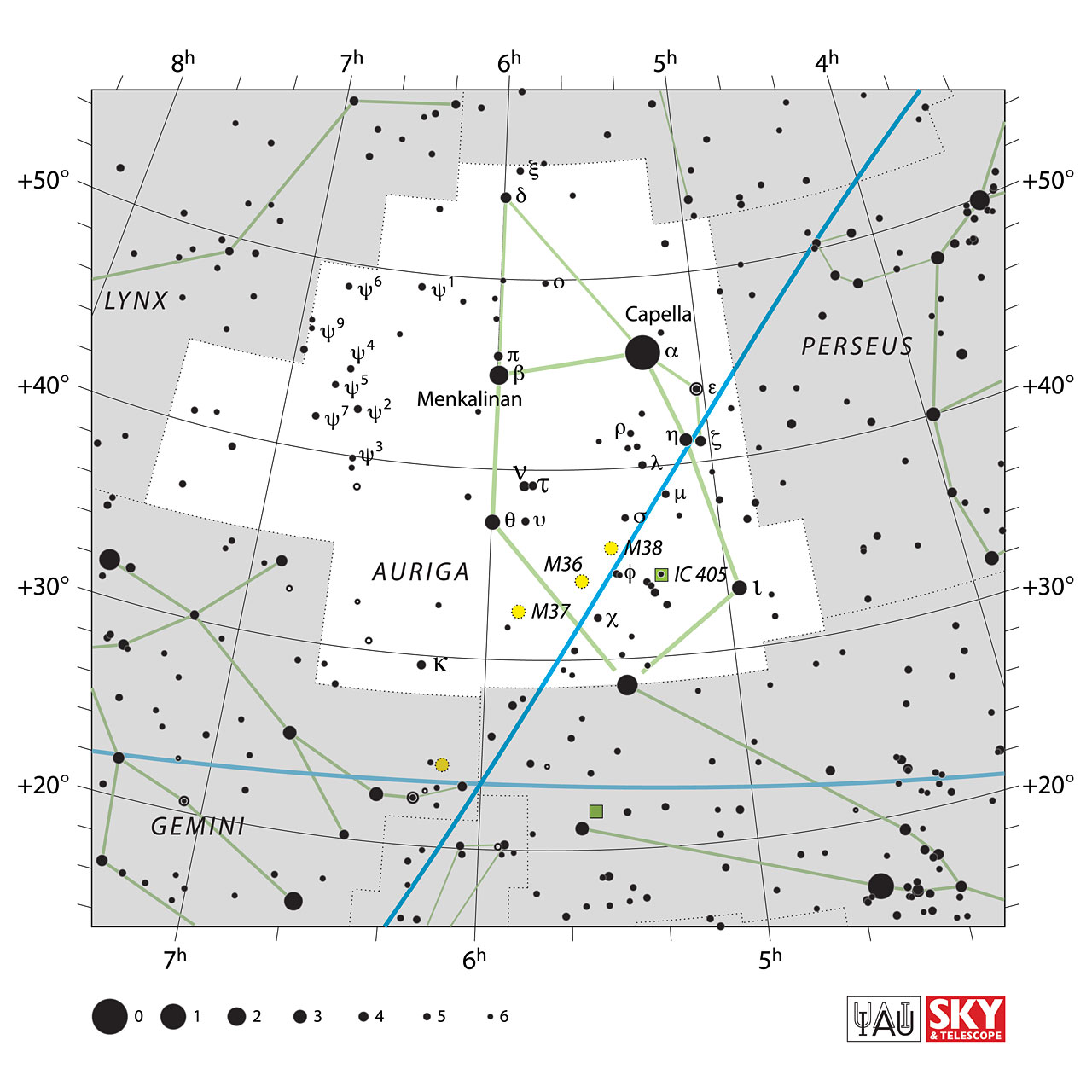Auriga


Auriga is a prominent constellation, visible in the far northern sky in the months around February. Its brightest star, Capella, is the sixth brightest in the sky. it was among the 48 constellations listed by the 2nd-century astronomer Ptolemy.
Lying close to the plane of the northern Milky Way, it is littered with open clusters, including M36, M37 and M38. These are groupings of young stars, recently formed in the Taurus–Auriga molecular cloud.
Auriga is identified in Greek mythology as a charioteer. The constellation Auriga is mentioned in two ancient stories. The first, relating to a charioteer, is that of Auriga, the crippled son of Vulcan and Minerva, who invented a four-horse chariot in order to get himself around. This became such an important invention that Zeus placed the first chariot into the skies with the other constellations. The second story, which is the older of the two, referred to Auriga as a gentle shepherd who, after finding one of his pregnant goats missing, went out into the hills and searched until he found her stranded on a rocky ledge with her two new kids. Placing her across his shoulders and carrying the two kids in his left arm, he returned to the rest of the herd. Some stories relate how the two kids commemorate the two daughters of the king of Crete who fed and cared for the infant Zeus.
Occasionally, Auriga is seen not as the Charioteer but as Bellerophon, the mortal rider of Pegasus who dared to approach Mount Olympus. In this version of the tale, Jupiter pitied Bellerophon for his foolishness and placed him in the stars.[
There are various conflicting accounts of Auriga’s identity in Greek mythology. One popular story is that he is Erichthonius, son of Vulcan, who was the first person to attach four horses to a chariot. Greek mythology has no explanation for why Erichthonius should be depicted holding a goat, and so the goat was probably once a separate constellation which has been awkwardly merged into Auriga.
The first record of Auriga’s stars was in Mesopotamia as a constellation called GAM, representing a scimitar or crook. However, this may have represented just Capella (Alpha Aurigae) or the modern constellation as a whole; this figure was alternatively called Gamlum or MUL.GAM in the MUL.APIN.
In ancient Hindu astronomy, Capella represented the heart of Brahma and was important religiously. Auriga is called ವಿಜಯ ಸಾರಥಿ (Vijaya Sarathi) and Capella is called Bhramahridaya.
Auriga contains:
-
Stars
- Capella (mag 0.1)
- Menkalinan (mag 1.9)
- θ-Aur (mag 2.6)
- ι-Aur (mag 2.7)
- ε-Aur (mag 3.0)
- η-Aur (mag 3.2)
- δ-Aur (mag 3.7)
- ζ-Aur (mag 3.8)
- ν-Aur (mag 4.0)
- κ-Aur (mag 4.3)
- π-Aur (mag 4.3)
- τ-Aur (mag 4.5)
- 16-Aur (mag 4.6)
- λ-Aur (mag 4.7)
- χ-Aur (mag 4.7)
- υ-Aur (mag 4.7)
- 2-Aur (mag 4.8)
- ψ²-Aur (mag 4.8)
- μ-Aur (mag 4.8)
- 63-Aur (mag 4.9)
- ψ¹-Aur (mag 4.9)
- ξ-Aur (mag 5.0)
- ψ⁷-Aur (mag 5.0)
- 9-Aur (mag 5.0)
- ω-Aur (mag 5.0)
-
Open Clusters
- NGC 2281 (mag 5.4)
- Messier 37 (mag 5.6)
- Messier 36 (mag 6.0)
- Messier 38 (mag 6.4)
- NGC 1857 (mag 7.0)
- NGC 1893 (mag 7.5)
- NGC 1664 (mag 7.6)
- NGC 1778 (mag 7.7)
- NGC 1907 (mag 8.2)
- NGC 1931 (mag 10.1)
- NGC 2126 (mag 10.2)
- NGC 2192 (mag 10.9)
- NGC 1883 (mag 12.0)
- NGC 1896
- NGC 1798
- NGC 1724
- IC 2168
- IC 406
- NGC 2240
-
Globular ClustersNone
-
Galaxy
View Auriga in 3D 
Source: Wikipedia, in-the-sky.org
Image Courtesy: Sky&Telescope & IAU, Illustration Images linked from Urania's Mirror on Wikmedia Commons by Sidney Hall
Image Courtesy: Sky&Telescope & IAU, Illustration Images linked from Urania's Mirror on Wikmedia Commons by Sidney Hall
